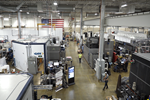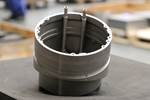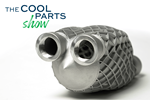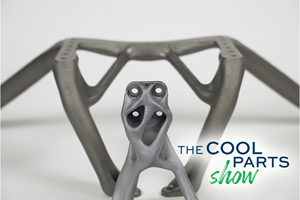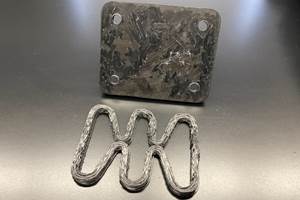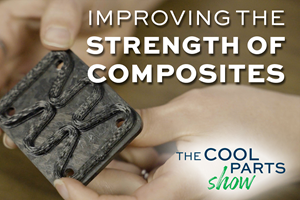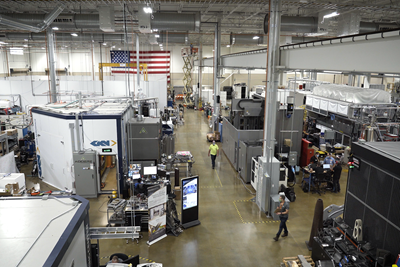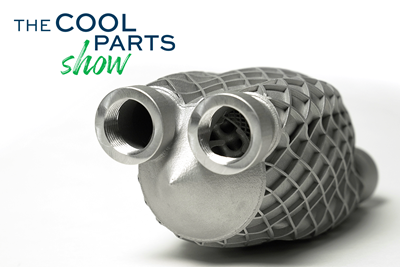A nuclear reactor is essentially a large-scale heat exchanger, a point Ryan Dehoff of Oak Ridge National Laboratory’s Manufacturing Demonstration Facility (MDF) notes in this latest episode of The Cool Parts Show. That means additive manufacturing offers considerable promise to improve energy efficiency by making complex forms that optimize heat transfer. But nuclear power is a conservative industry focused on safety and reliability — additive manufacturing has to prove itself first. A set of 3D printed stainless steel brackets currently in use at the Browns Ferry nuclear power plant is part of the test. Manufactured by the MDF in partnership with nuclear equipment supplier Framatome, the brackets help secure a nuclear fuel assembly. Learn more about the way ahead for AM and nuclear power in the episode below. | This episode of The Cool Parts Show brought to you by Carpenter Additive
The Cool Parts Show is a video series from Additive Manufacturing Media that explores the what, how and why of unusual 3D printed parts. Watch more here.
Have a cool part to share? Email us.
Related Resources
- Framatome
- About the Manufacturing Demonstration Facility at Oak Ridge National Laboratory
- Additive manufacturing for heat exchangers
- What is laser powder bed fusion?
Transcript
Peter Zelinski
Can additive manufacturing play a role in nuclear power? The first 3D printed part in a nuclear reactor on The Cool Part Show.
I'm Pete.
Stephanie Hendrixson
I'm Stephanie.
Peter Zelinski
Welcome to The Cool Parts Show.
Stephanie Hendrixson
This is our show all about cool, unique, interesting, possibly radioactive 3D printed parts.
Peter Zelinski
Yeah, we'll get to that. We're at Oak Ridge National Lab, we're doing a variety of episodes on additive manufacturing successes being advanced by the Manufacturing Demonstration Facility.
Stephanie Hendrixson
We are standing in the Advanced Characterization Lab, the result of a partnership between Oak Ridge and Zeiss. And we're here to talk about one of our favorite topics.
Peter Zelinski
A bracket! Seemingly simple part made through additive manufacturing, not as simple as it seems. We'll get into that. But first, Stephanie, why do we love brackets?
Stephanie Hendrixson
We love brackets because they are everywhere. They are these really functional parts that do all kinds of things to the point that we take them for granted. But when you pair them with 3D printing, they can be a really valuable and a really accessible case study for what it can do.
Peter Zelinski
Additive manufacturing loves brackets. The typical off the shelf bracket almost always uses too much material for the function that it's asked to perform. Additive manufacturing, 3D printing offers the way to more material efficient, more mass efficient brackets.
Stephanie Hendrixson
So usually when we talk about brackets in the context of 3D printing, we're looking at these things that look really topology optimized, very organic, and this bracket looks pretty conventional. So what's going on here.
Peter Zelinski
Special bracket. This is a bracket for a nuclear reactor.
Stephanie Hendrixson
Should you be holding that?
Peter Zelinski
Good question. So this isn't the actual bracket, but it is identical to a set of brackets currently in use in the Browns Ferry nuclear power plant in Alabama, making the sister parts to this component quite possibly the first 3D printed components to find use inside a nuclear power plant.
Stephanie Hendrixson
Okay, very cool. But what does this bracket do inside of a nuclear reactor?
Peter Zelinski
This bracket helps to hold the fuel assembly in a reactor. Inside of a nuclear reactor, as you'd imagine, there are all of these hardware systems and safeguards that protect against various risks, including some very unlikely risks. And that sort of describes the use of this bracket. It is part of the system that protects against extreme vibrations. Like if the power plant experienced an earthquake, say. So, why don't I introduce Ryan Dehoff? He is deposition science and technology group leader here at Oak Ridge, and he can explain in more detail.
Ryan Dehoff
So inside of a nuclear reactor, you have something called a fuel assembly bundle. And these are basically bundles that are filled with nuclear fuel that are then inserted into the reactor. And this bracket plays a role of keeping those bundles in the right location inside of the reactor, making sure that vibrations and movement are minimized during operation. And so they're effectively responsible for helping to make sure that the reactor functions properly. Framatome actually owns these fuel assembly bundles that go inside of the nuclear reactor for the Tennessee Valley Authority. And so Framatome is really the one that is responsible for the operation of these assemblies and these brackets inside of an actual reactor. And so as part of this project, they're the ones that helped us to outline the metrics that had to be achieved, the performance specifications, tolerances and certification of qualification, because if something goes wrong, they are the responsible party over the work. And so they have to ensure that these brackets are capable of performing.
Stephanie Hendrixson
So this unassuming bracket is actually pretty important to the proper operation of the nuclear reactor in the event of some kind of accident. So tell me more, how was this 3D printed?
Peter Zelinski
3D printed in 316 stainless steel, laser powder bed fusion on a machine from Concept Laser. But 3D printing is not the entire process.
Ryan Dehoff
The challenge is that the geometric accuracy and tolerances required for this component were significantly greater than what can be achieved currently today in that 3D printing process. And so we had to go through and figure out how to machine the part after we printed it in order to maintain that geometric accuracy that we required on the component. So we used a combination of printing, machining and post finishing in order to achieve the actual final component.
Stephanie Hendrixson
So that answers how this was made. But I still don't really know why. Why would you want to 3D print the first bracket to go into a nuclear reactor?
Peter Zelinski
Right. So additive manufacturing is transformative, but it is not the right solution for every part. Why make this part through 3D printing? Why make it additively? So the material is part of the answer to that. This is 316 stainless steel. So that is a material that has been accepted for use in the nuclear power industry and a material that we know very well how to 3D print effectively, how to produce through laser powder bed fusion. So that set of circumstances kind of created the opening to apply additive manufacturing for making this part. And that's really the reason why it's not just about this part, but it's about additive manufacturing. Additive, 3D printing holds a lot of promise for the nuclear power industry, and this component is possibly the beginning of that. Ryan has more to say about that.
Ryan Dehoff
Yeah, so I think everybody knows the potential that additive manufacturing technology has. We have the ability to build extremely complex geometries. And essentially a nuclear reactor is a very, very large scale heat exchanger. And so additive manufacturing enables you to be able to print these very complicated and complex designs. And so I think that there could be a very, very large impact in additive manufacturing technologies inside of the nuclear industry. The challenge is that we do have to certify and qualify components. Now, there's people in the industry that have certified and qualified components in the medical industry, we've seen aerospace. And so I think the next thing is kind of nuclear. And if we can certifying qualified parts to go inside of a nuclear reactor, I think that we can certify and qualify parts to do nearly anything.
Peter Zelinski
So that's really the challenge. The nuclear power industry is characterized by a lot of certification requirements, a lot of controls. It's a very conservative industry, as you would want it to be. So this component offered the chance not just to prove out 3D printing in a part that goes into a reactor, but also to pioneer the process for how you certify an additively manufactured part. And it turns out additive manufacturing not only brings the promise of a lot of new design freedoms for nuclear power components, but also potentially a new level of capability when it comes to certifying parts.
Stephanie Hendrixson
So part of what's really interesting about this bracket is that just for the sake of getting a 3D printed part into a nuclear reactor that could be certified, they took all the other variables out of this. So we know the design of the existing bracket. Let's keep that exactly the same. We know the material that works in this application. Let's use the same material. And so really what we're testing here is just the additive manufacturing process. Can 3D printing deliver an equivalent bracket?
Peter Zelinski
So that's right. And those constraints created the opportunity for additive. They're now working out the process. And part of that process involves developing a new mode of certifying a component.
Ryan Dehoff
I think the biggest challenge with the nuclear industry is certification and qualification. Right. And this is something that has really hindered advanced manufacturing technologies from being implemented into the nuclear industry holistically. Part of that challenge is we really need to understand how that material is going to perform in service. What we have done here at Oak Ridge is come up with a digital platform for the additive manufacturing technology that combines in-situ process monitoring, computer vision, in-situ sensing, all that goes into the digital platform that we can help to aid the certification and qualification process. We combine that with post inspection data, material properties, microstructure analysis and all of that goes into a digital package that could be used to certify and qualify components significantly cheaper than what we do today. Unfortunately, with this process, we haven't proven that technology in the nuclear industry yet today. And so with this particular bracket, what we did is we certified and qualified it using that digital platform that we've been developing, but we've also certified and qualified it using the conventional processes that have been established for many, many years here at Oak Ridge and with Framatome, and they then certified and qualified that to go into the reactor. And so we really certified it twice in a way. And really what we're trying to do is see if that digital platform could eventually replace the conventional inspection technologies at a much, much cheaper cost.
Stephanie Hendrixson
So at this point, Oak Ridge has produced some of these brackets. They've certified them. There are some in the nuclear reactor. How long until we know if this worked?
Peter Zelinski
Six years. That particular reactor will next see maintenance service in six years. At that point, these 3D printed brackets will be removed. They'll go back to Oak Ridge and the researchers here will look at them closely, study them closely to determine that these components performed just as well as conventionally manufactured brackets.
Stephanie Hendrixson
And so once that happens, if we find that the brackets performed as expected, what could that mean for nuclear reactors and the energy industry?
Peter Zelinski
Two things. One, the design freedoms of additive manufacturing brought to the nuclear power industry. And that means potentially more geometrically efficient parts, more cost and material efficient parts, maybe better performing components. That's one. But another is with this direct digital manufacturing process, additive manufacturing, there is the potential for a more efficient and capable certification process, a digitally enabled certification process.
Stephanie Hendrixson
Okay. I think I got this.
Peter Zelinski
Alright, take it.
Stephanie Hendrixson
So this is a bracket produced by Oak Ridge for Framatome. It is part of the fuel assembly for a nuclear reactor. Specifically, it protects against vibration. It was 3D printed using laser power bed fusion on a concept laser machine. It is made out of 316 stainless steel. And part of what's interesting about this bracket is that the design is the original design of the existing component. The material is one that's already in use in nuclear reactors. And really what they were testing here is just can you put a 3D printed bracket into a nuclear reactor and expect the same kind of performance as you would from a conventional bracket? So this part was 3D printed. It had some finished machining. It was inspected here in this lab, and it was also certified in two different ways. It went through a conventional certification process, as well as a new digital certification process, which could be a faster, easier, cheaper way of certifying parts like this in the future. Some of these brackets are in a nuclear reactor now. They will stay there for six years and then they'll come back to Oak Ridge. They'll be able to study and analyze the performance and see if 3D printing can really hold up in a nuclear reactor.
Peter Zelinski
That'll do it. If you have a cool part to share, if you have a cool bracket to share. Email us. CoolParts@AdditiveManufacturing.media.
Stephanie Hendrixson
Thank you again to our hosts at Oak Ridge. If you want to see all the episodes that we are filming here at the MDF, you can find them on our YouTube channel or at TheCoolPartsShow.com.
Peter Zelinski
If you like the show, leave a comment. Be sure to subscribe. Thank you for watching.
Related Content
3D Printed "Evolved Structures" for NASA Exoplanet Balloon Mission: The Cool Parts Show #61
Generative design creates stiff, lightweight brackets for EXCITE mission monitoring planets orbiting other stars. The Cool Parts Show visits Goddard Space Flight Center.
Read MoreTo Improve Performance of Compression Molded Composites, Add 3D Printed Preforms
9T Labs' Additive Fusion Technology enables the manufacture of composite structures with as much or as little reinforcement as is necessary, using 3D printed continuous fiber preforms to add strength just where needed.
Read More3D Printed Titanium Replaces Aluminum for Unmanned Aircraft Wing Splice: The Cool Parts Show #72
Rapid Plasma Deposition produces the near-net-shape preform for a newly designed wing splice for remotely piloted aircraft from General Atomics. The Cool Parts Show visits Norsk Titanium, where this part is made.
Read More3D Printed Preforms Improve Strength of Composite Brackets: The Cool Parts Show Bonus
On this episode, we look at a pin bracket for the overhead bin of an airplane made in two composite versions: one with continuous fiber 3D printed reinforcements plus chopped fiber material, and one molded from chopped fiber alone.
Read MoreRead Next
Video: What is the Manufacturing Demonstration Facility at Oak Ridge National Laboratory?
This industry-focused organization within the Department of Energy helps manufacturers make use of advanced technology, particularly 3D printing. One of the group’s leaders describes how companies work with the MDF.
Read MoreExperimental Fusion Reactor To Use Rosswag AM Cooling Heads
Rosswag Engineering has produced 3D-printed cooling heads for a plasma-exposed environment in the Wendelstein 7-X fusion reactor.
Read More3D Printed Heat Exchanger Uses Gyroids for Better Cooling | The Cool Parts Show #43
Replacement heat exchanger for a helicopter is half the size and delivers 4× the cooling, thanks to a geometry that could only be made via additive manufacturing.
Read More


